Quality of dental restorations. FDI Commission Pro... - ResearchGate
Quality of dental restorations. FDI Commission Pro... - ResearchGate
Quality of dental restorations. FDI Commission Pro... - ResearchGate
Create successful ePaper yourself
Turn your PDF publications into a flip-book with our unique Google optimized e-Paper software.
130marginal degradation compared tothe other tooth groups. Osborneand Gale 130 reported that themarginal fracture <strong>of</strong> high-copperamalgam <strong>restorations</strong> could not berelated to the intraoral locationafter fourteen years service. Interactionsbetween tooth position andwidth indicated that lowerpremolars with conservative <strong>restorations</strong>exhibited the least fractureat the margins, and upperpremolars with a wide preparationexhibited the most. Osborne andGale 131 reported that the marginaldegradation <strong>of</strong> 429 Class II amalgamsafter two years was less inlower premolars than in the otherposterior teeth.Goldberg et al. 132 studied 475<strong>restorations</strong> over 1.5 years. UsingANOVA analyses, these investigatorscompared marginal fracturescores among different subgroups,categorised by intraoral location andfound more fractures in molars thanin premolars.Oral environmentDerand 133 assessed <strong>restorations</strong> <strong>of</strong>four amalgam alloys in 163 teethafter 2.5 years. The patients weredivided into three levels <strong>of</strong> bitingforce. It was found that marginalfractures increased with increasingbite force for the conventionalalloys, but that the relationship wasnot significant for the three nongamma-2alloys.Restoration failure andclinical factorsTechnical excellence <strong>of</strong> <strong>restorations</strong>deteriorates in clinical service andmay or may not be linked to restorationfailure. Certain investigators,including those <strong>of</strong> Harris 134 andOwens 135 , reflect a common opinionthat materials themselves are<strong>of</strong>ten the least <strong>of</strong> the problems andthat most restoration failures canbe attributed to poor attention todetail in cavity preparation andmaterial handling. However, thisview can at best be regarded asexpert opinion, and is linked to thefailure criteria. In a survey <strong>of</strong> 571International Dental Journal (2001) Vol. 51/No.3dentists, perceived causes <strong>of</strong> restorationfailure were ranked bypatient-related factors (45 per cent),dentist-related (35 per cent) andmaterial choices (20 per cent) 136 . Anamusing secondary finding was thatthese estimates were for <strong>restorations</strong>in general, while the percentageswere 48, 26 and 26 per centrespectively when dentists addressedthe causes <strong>of</strong> failure <strong>of</strong> the <strong>restorations</strong>they had made themselves.The following sections presentthe effects <strong>of</strong> the numerousdependent and independent variablesinfluencing the quality <strong>of</strong><strong>restorations</strong>, notably the operator;the operative techniques and instrumentused; the material; the location;type; size; initial and short-termtechnical excellence <strong>of</strong> the restorationand patient factors.General performanceMaterial factorsDifferences in composition andphysical propertiesSubtle differences in physical propertieswithin specific materialgroups may be considered to havea small effect on clinical performancein general practice settings. Aparticular exception is perhaps compositeresin cements for indirect<strong>restorations</strong>, where the micr<strong>of</strong>illedcements seem to be superior tocements with larger fillers 14,136 ,although conflicting results havebeen reported 138 . Two longitudinalmulticentre studies involving 24dentists in seven clinics revealed onlyminor differences amongst sixcomposite resins after three andfive years 139,140 . Dunne and Millar 141reported the evaluation <strong>of</strong> 315porcelain labial veneers in 96patients, fitted up to five yearspreviously in two teaching hospitals.Increased problems and failurerates were associated with veneerswhere inappropriate luting agentswere employed, that is, lutingcements not dedicated to veneercementation. In studying over 1,544amalgam <strong>restorations</strong>, 1,213 <strong>restorations</strong>remained after 15 fifteenyears. The conclusions from thisstudy was that the type <strong>of</strong> amalgamalloy used had no associationwith restoration survival 108,109 . VanNoort and Davis 142 observed in afive-year prospective study thesurvival <strong>of</strong> 2,399 Class III and 1,093Class V chemically-activated anteriorcomposite resin <strong>restorations</strong> in26 general <strong>dental</strong> practices, that thedifferences in clinical performancesbetween six materials was small. Ina cross-sectional study, 75 privatepractitioners evaluated 1,147 twoto-fouryears old anterior <strong>restorations</strong><strong>of</strong> 25 different materialsaccording to the CDA system. Withthe exception <strong>of</strong> one compositeresin, no obvious differences in thequality <strong>of</strong> <strong>dental</strong> <strong>restorations</strong> wereobserved 33 .Operator factorsAmong various clinical factorsaffecting restoration performance,an operator association is frequentlydetected in multicentre and crosssectionalstudies (Table 1). Controlledclinical studies are usually designedto avoid such operator effects, anddifferent research groups haveemployed various strategies (seesection on statistical issues) tocontrol these effects.Most <strong>of</strong> the relevant papers<strong>of</strong>fer no explanation <strong>of</strong> theobserved variation in operatoreffect, although some authors stressthe necessity <strong>of</strong> specific training for<strong>dental</strong> personnel using new materials.It is also possible that anindirect patient association may haveinfluenced an apparent operatorassociation. Whether the experience<strong>of</strong> the operator can be associatedwith technical excellence is uncertain.For example, Hawthorne andSmales 150 reported that the survivalfor composite resin <strong>restorations</strong>was best for the most recent graduates.By contrast, Shaini et al. 151commented that the poorestresults were seen in relation to theinexperienced operators. Of course,appropriate clinical training andexperience are necessary prerequisitesfor favourable clinical outcomes.


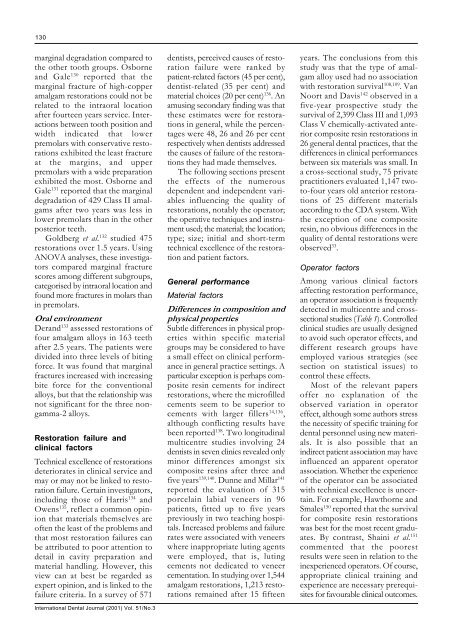

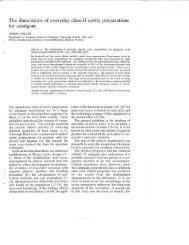
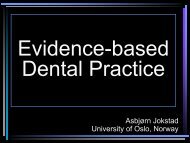
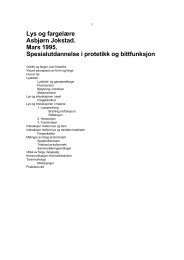

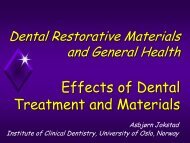
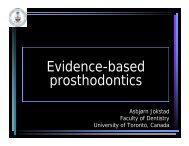

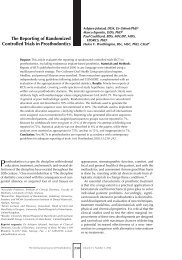
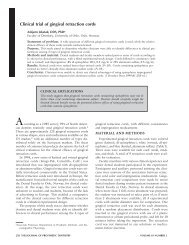

![[Sementer i fast protetikk] Scandinavian Society for Prosthetic](https://img.yumpu.com/18378889/1/190x245/sementer-i-fast-protetikk-scandinavian-society-for-prosthetic.jpg?quality=85)
